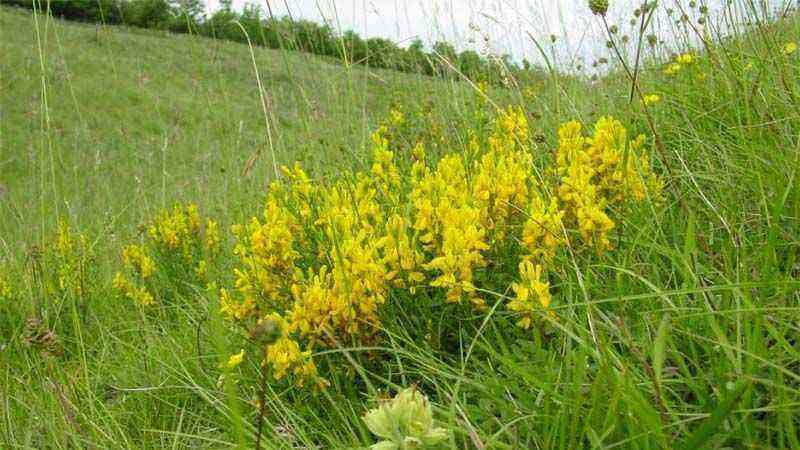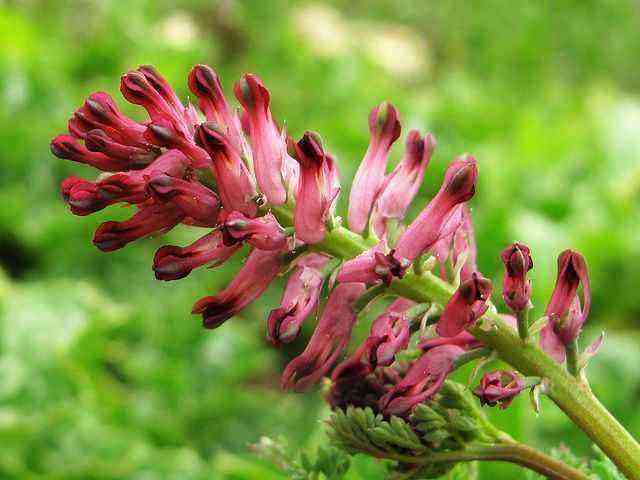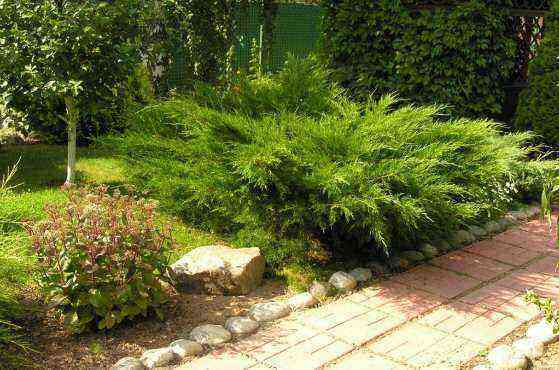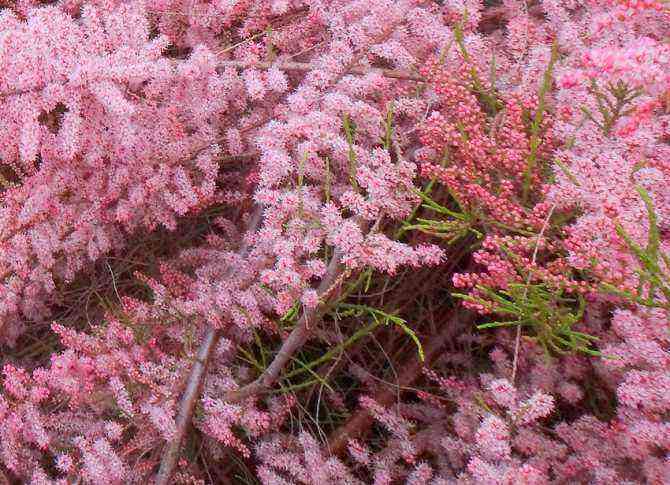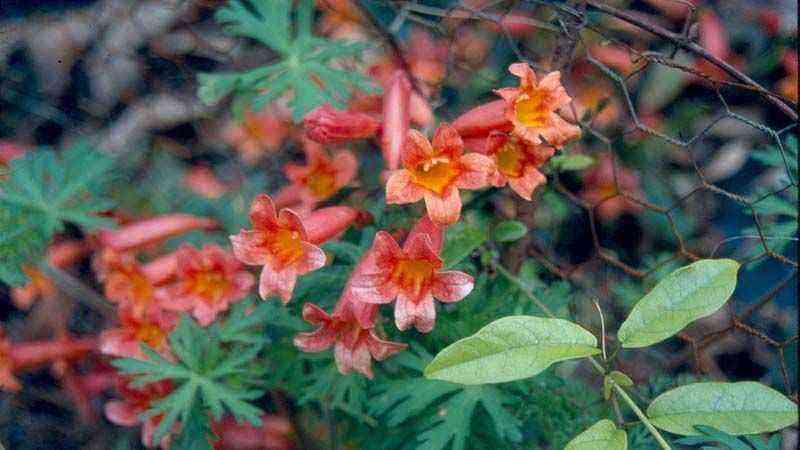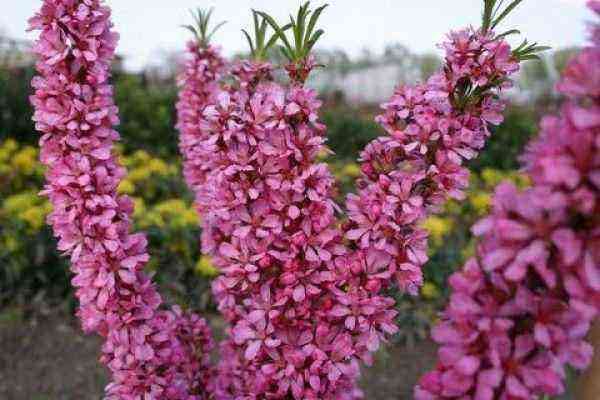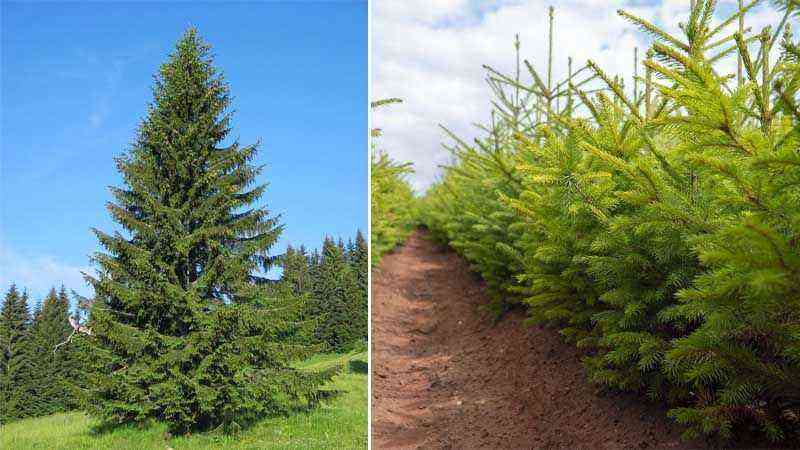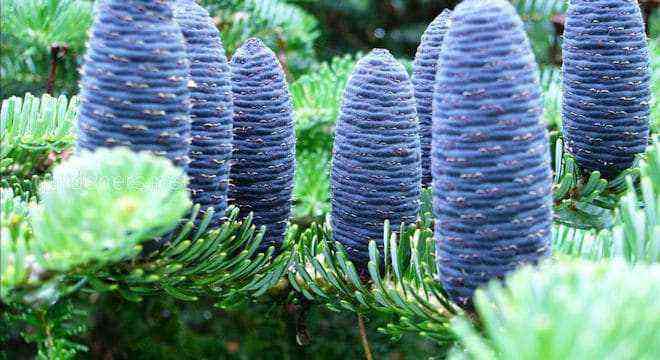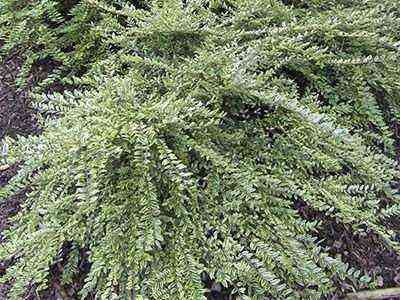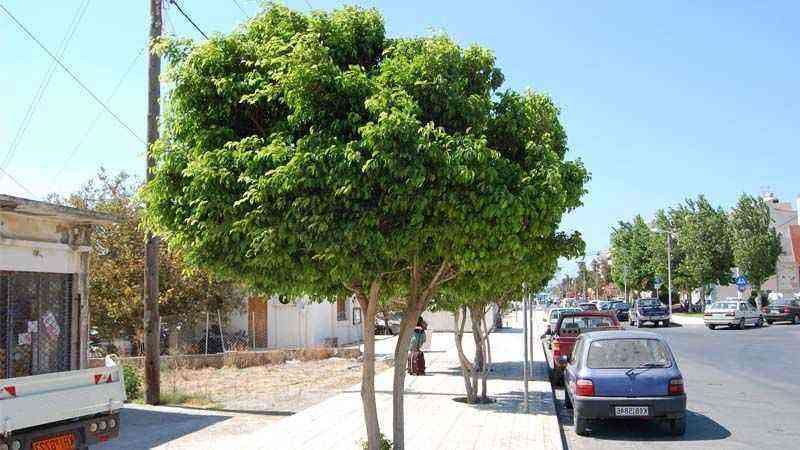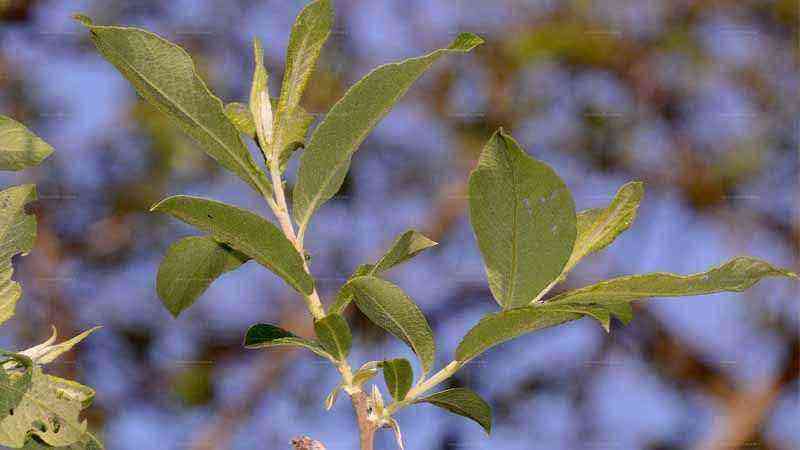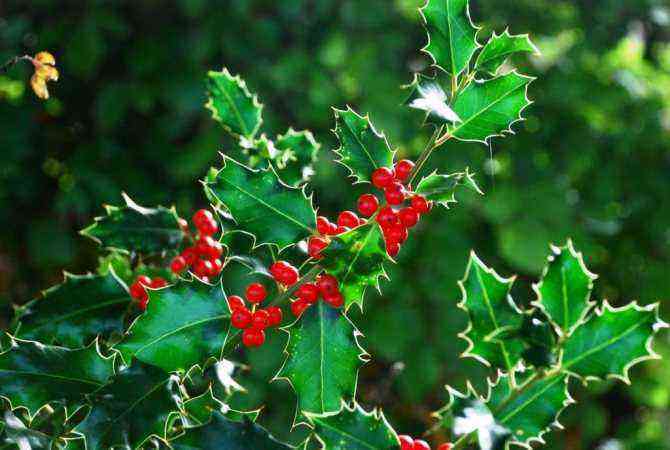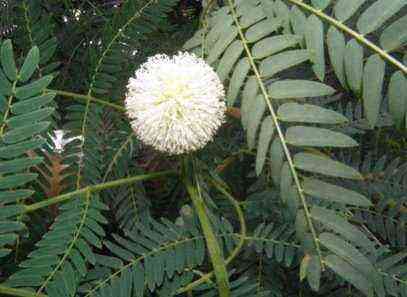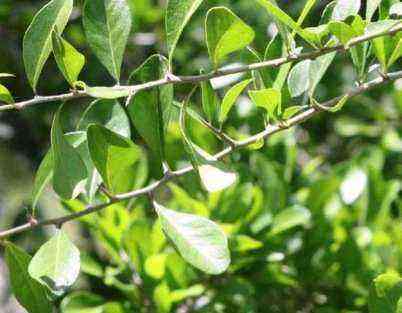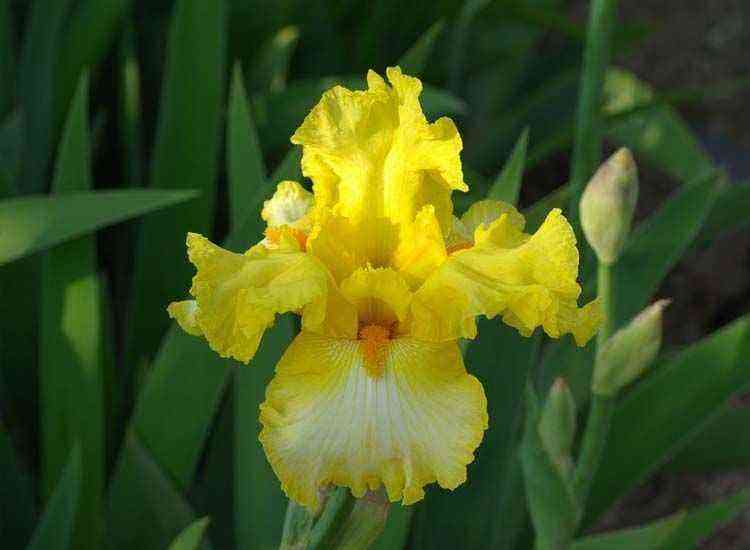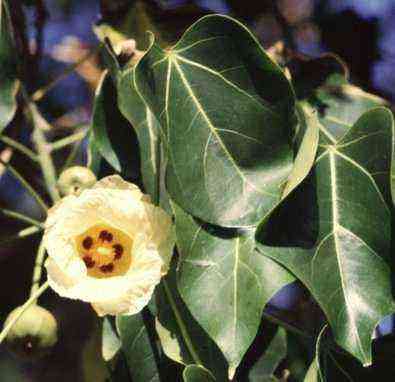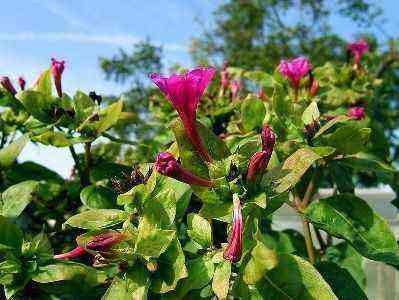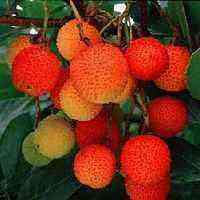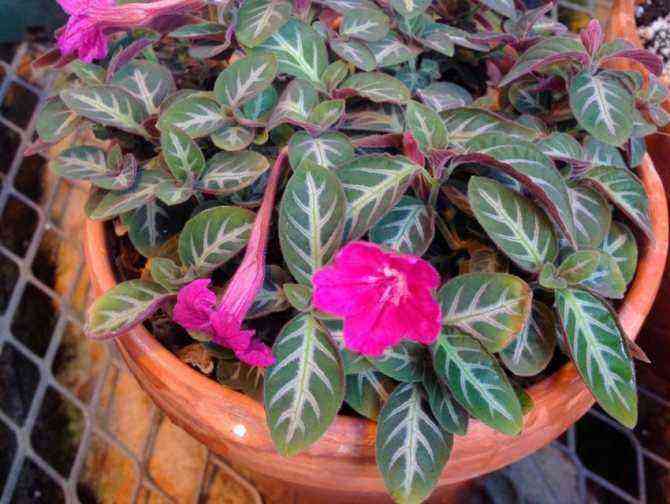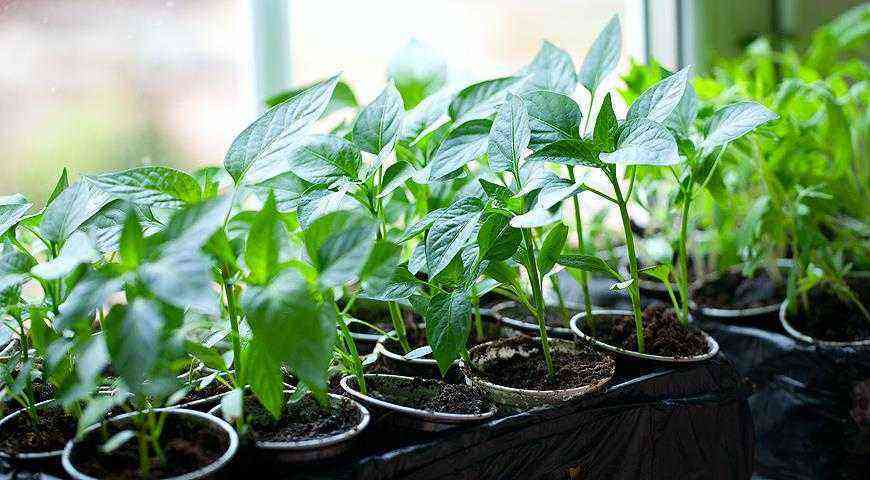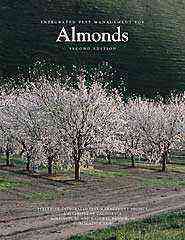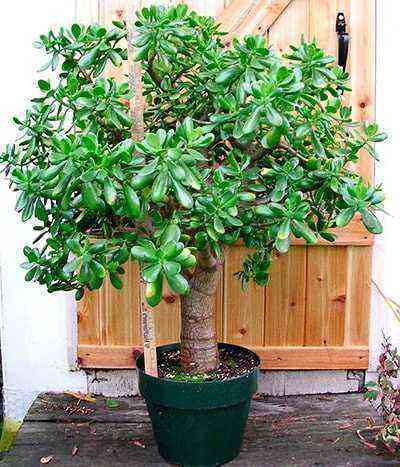Clematis is also called Clematis or Lozinka. Plants included in this genus are referred by botanists to the Ranunculaceae family. They are mainly distributed in the northern hemisphere, where a temperate climate prevails. They prefer to settle both in forests and on the coastal lands of river arteries, they can cover slopes and cliffs, they are found in impenetrable shrub thickets or in steppes and steppe meadows. Sometimes they grow well on saline soils. There are about 300 different species in the genus, differing from one another in appearance and colors.
| Family name | Buttercup |
| Growth cycle | Long-term |
| Growth form | Herbaceous or woody |
| Reproduction type | Seed and vegetative |
| Transplant time to the garden | In spring or autumn |
| Disembarkation scheme | Leave 15-20 cm between seedlings |
| Substrate | Sandy or loamy, loose and nutritious |
| Indicators of soil acidity, pH | From slightly acidic (5-6) to slightly alkaline (7-8) |
| Lighting level | Sunny location or partial shade |
| Recommended humidity | In the summer heat it is abundant 2-3 times a week, usually only once every 7 days |
| Special requirements | No |
| Height indicators | 0,6-5 m |
| Color of flowers | Snow white, yellow, from pale pink to crimson, from pale blue to ink |
| Inflorescences or type of flowers | Single arrangement or in panicle / semi-umbellate inflorescences |
| Flowering time | Directly depends on the species – from the first days of April to October |
| Decorative period | Spring-autumn |
| Places of application | Landscaping of columns of terraces, borders, gazebos and pergolas, decoration of balconies |
| USDA zone | 4-6 |
The plant bears its name in Latin thanks to the word “clematis”, which translates as “vine shoot” or “branch”, in fact, means “climbing plant”. However, then other garden plants with climbing branches began to be called so. In this case, the stress should be placed on the first syllable “e”, and not on the middle (letter “a”), as many are accustomed to. But among the people there are many synonymous names for this decorative representative of the flora – vine or clematis, grandfather’s curls and warthog. On the territory of Russia, it is called a clematis according to some versions due to the fact that the shoots of this decorative liana can form impassable thickets that will not allow free movement, while you can fall and break your nose. Another explanation says that this name was given because of the unpleasant odor that the roots give off.
All varieties of clematis are perennials with a herbaceous, shrub, semi-shrub or woody form of growth. The root system can be rod-shaped or fibrous. If the plants have the first type of roots, then the transplant is very difficult to transfer.
The stems are liana-like, curly and climbing, in rare cases they have straight outlines. If the species is woody, then its shoots are faceted with a brown tint, in herbaceous species the shape of the branches is rounded, and the color is green. Clematis leaf plates grow in opposite order, whole. Their shape can be trifoliate, odd-pinnate or dvazhdytrychaty. The color of the leaves is a rich dark or light green.
It is flowering that is the dignity of this decorative liana. The buds begin to bloom from April to October, but this directly depends on the type of plant. Flowers are bisexual. The corolla of the flower is large, the arrangement is single, but in some species they can gather in inflorescences with a semi-umbilical or panicle shape. A large number of stamens and carpels are present inside the corolla. There are usually two pairs of petal sepals in the perianth, in rare cases their number is 5–8 units. If the variety has double flowers, then the number of petals can reach 70 pieces. In some species, the characteristic difference is the presence of staminodes, which have petal-shaped outlines or modified stamens. The color of the petals is very diverse – from snow-white to dark purple.
The flower remains fresh for 15–20 days. When blooming, there is an aroma reminiscent of almonds, jasmine or primrose. After pollination, the fruits ripen, which in clematis are presented in the form of multi-roots with elongated noses with a pinnate coating (called stylodia). This natural adaptation ensures that the seeds are easily carried by the wind. For all its decorative effect, the plant is absolutely undemanding.
Description of the types and varieties of clematis
All varieties of clematis are divided into groups characterized by the location of the formation of flower buds:
- Group A
– flower buds are formed on the shoots of last year’s season. - Group B
– the bushes from this association delight with flowers that unfold on the branches of last year and the current vegetative season. - Group C
– the buds will appear exclusively on the shoots that have grown this year.
However, the people also adopted a division according to the size of the opened flowers: large-flowered, medium-flowered and with small flowers.
Group A


Alpine Clematis (Clematis alpina).
The shoots of this vine can stretch up to 3 m. The size of the leathery leaves is large, the flowers are small, the corolla is tubular, the petals are blue. The buds bloom on the days of August. Let’s apply as a border culture. The most common varieties:
- Artagena Franki(Artagena Franks).
The corolla has the shape of a bell, the heads of the flowers are inclined downward. The color of the petals is azure with a white base. The length of the branches is 2–2,4 m. - Albina Plena
possesses flowers with snow-white petals and a double structure. The flowering time is May-June, the length of the branches is up to 2,8 m. - Pamela Jackman.
The maximum height of the branches ranges from 2–3 m. Downward sloping corollas are characterized by blue-violet petals. The length of the flower is 6-7 cm. The opening of the buds for the first time occurs in April-June, the second wave – from July to August, but fewer flowers are formed.

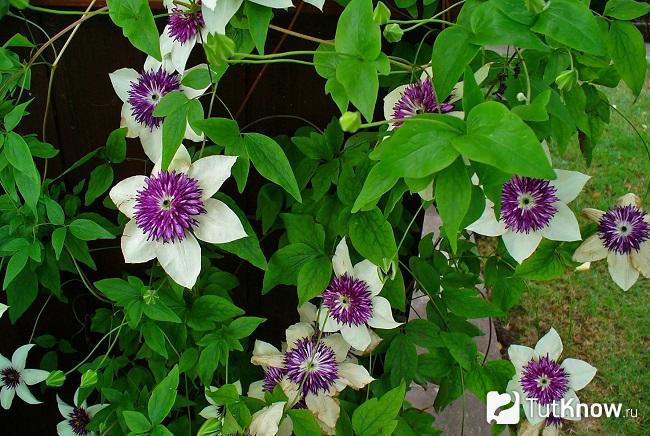
Clematis florida (Clematis florida).
The height of this woody plant is 3 m. Fragrant single flowers are rather large, the color of their petals is light. There are also two-tone variations. The best varieties:
- Vyvyan Pennell
– the structure of the corolla is terry, the color is lilac, the diameter of the opening of the bud is 12-15 cm. - Baby
the outline of the corolla is cruciform, the petals are lilac, with an azure undertone, the diameter reaches 10-14 cm. - Jeanne d’Arc
when flowering, a fragrant aroma is released, the flower is compact, the shape is terry, the color of the petals is white.

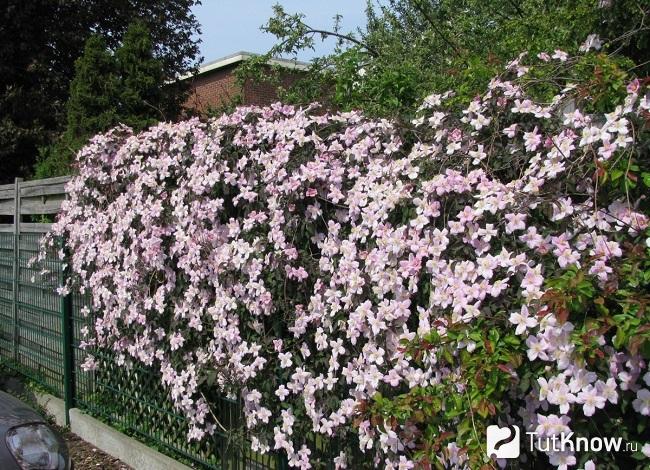
Mountain Clematis (Clematis montana)
the branches of this plant reach a height of 9 m. The pointed leaf plates are small, collected in whorls of 5 units. The buds are crowned with long pedicels. The petals are snow-white, the stamens are yellow, the corolla diameter is 4–5 cm. Winter hardiness is low. Favorite varieties of flower growers:
- Rubens –
the length of the branches is 6 m, the leaf plates are trifoliate, the shape of the leaf lobes is oval, their tops are pointed, the color is bronze, the diameter of the corolla is 6 cm. - Grandiflora
the branches do not exceed 5 m in length, the foliage grows in bunches, the leaflets are arranged close together, the shape is trifoliate, the corolla when opening is 5 cm, the flowers are fragrant, the inflorescences are bundle-shaped. The color of the sepals is whitish-pink or snow-white, the anthers are yellow. Flowering occurs in May-June.
Group B
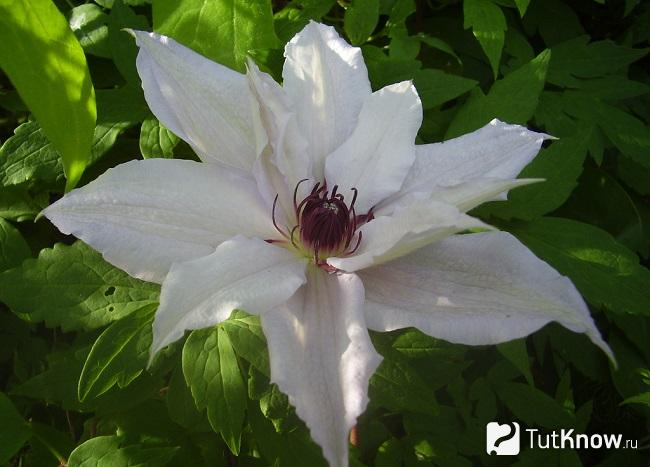

Woolly Clematis (Clematis lanuginosa).
The branches do not exceed 2,5 m in length. The diameter of the bud, when fully opened, is commensurate with 20 cm. The shade of the petals is white, pinkish or blue. The first flowering occurs in May-June, the buds open on last year’s branches. 1nd bloom – last August weeks, flowers will be on this year’s shoots. The best varieties are recognized:
- Madame le Coultre (Mme le Coultre).
2,5-3 m – these are the measurements of the length of the shoots. Leaves are whole or lobed, they are found in a simple or triple form. The diameter of the flower at opening is 14–20 cm. Sepals are whitish, anthers are light. The opening of the buds occurs in July. - Hybrida Sieboldii
the stems do not exceed 3 m in length. The diameter of the opened corolla is about 16 cm. The color of the sepals is light lilac, but the shade is darker along the edge, the anthers are red-brown. Bloom – July-September.

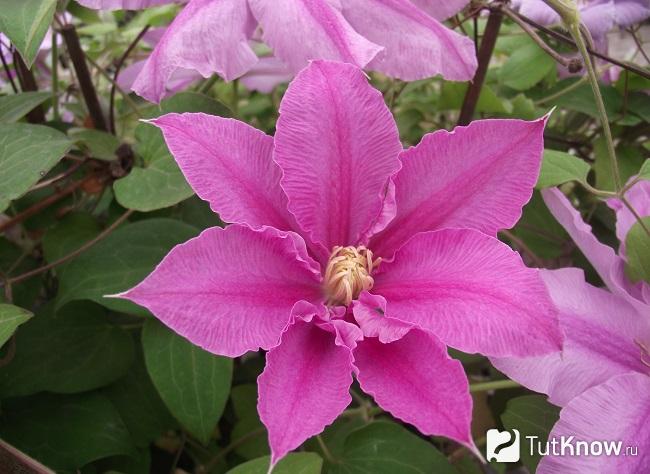
Spreading clematis (Clematis patens).
The shrub vine can reach a height of 3,5 m with branches. The corolla diameter in the opening is 15 cm and more. The color of the petals is very different – from snow-white to dark blue. Bicolor varieties have also been bred. The shape of the flowers is in the form of stars, simple or terry. On last year’s shoots, buds bloom in May-June, the second time flowering can occur in the fall, while flowers adorn the branches of this year. All varieties are not frost resistant. The best among them are recognized:
- JoanPicton
(corolla diameter – 22 cm, color – pale lilac with lilac tint); - Multi Blue
(the length of the stems is 2,5 m, the flowers are double, the color is blue-violet, the diameter of the opened corolla is 14 cm).
Group C
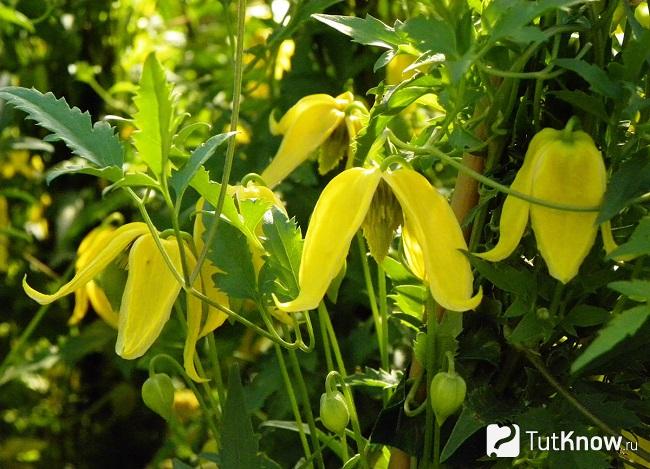
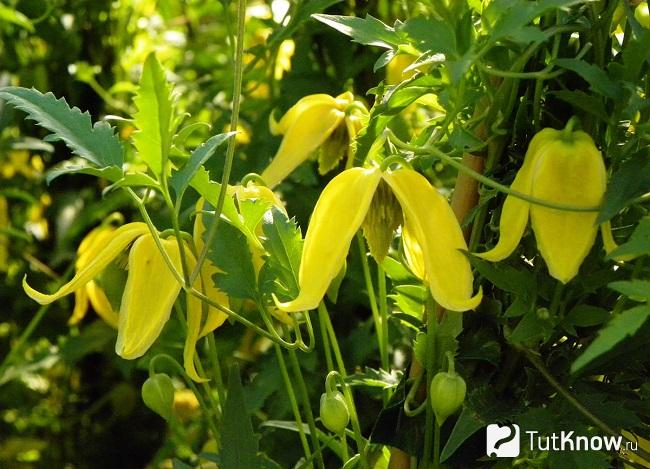
Clematis tangutica.
Vine growth is rapid. Flowers have a bell-shaped corolla, yellow petals. Frost resistant, does not require shelter in winter.
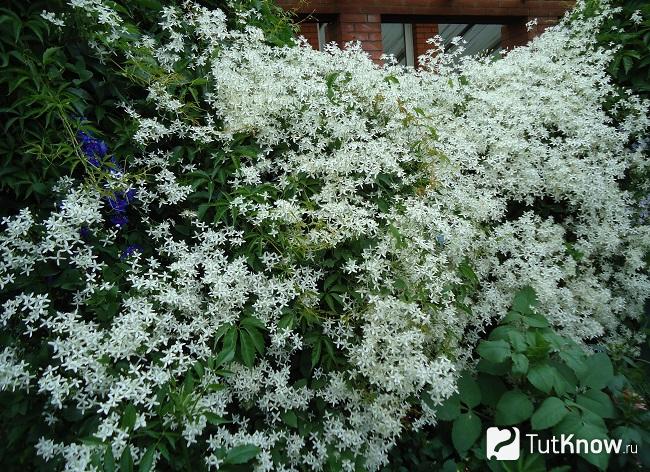
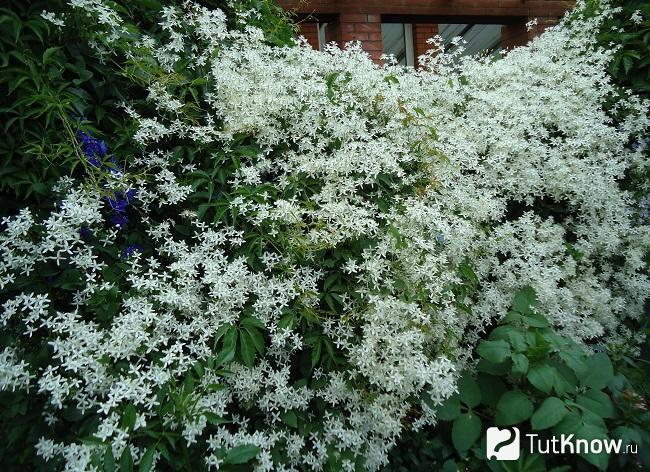
Clematis small-flowered (Clematis flammula).
The growth rate of the vine is high. Small cross-shaped flowers, fragrant, collected in inflorescences. The petals are snow-white. The length of the shoots is not more than 5 m. The leaves are with a complex-pinnate shape, the color is dark green. It blooms from mid to late summer.
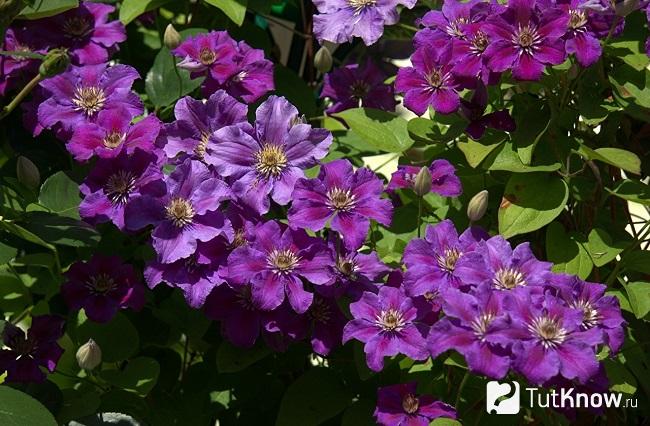

Clematis violet (Clematis viticella)
with flowers from saturated to light purple color. The corolla is simple, drooping. The diameter at the opening is 10–20 cm. The length of the branches does not exceed 3,5 cm, the growth rate is high. Blooms all summer until September. The best varieties:
- Ville de Lyon
with carmine-red flowers reaching a diameter of 10-15 cm. - Viola (Viola)
possesses a dark purple color of flowers with lilac veins, their diameter is 10-14 cm.
Varieties of varieties
There are various classifications of the vine. Lovers classify them by flower size: small, medium and large-flowered plants. But according to the international division, the clematis varieties look like this:
- Group “A” – plants blooming on the shoots of the last season (Alpina, Florida, Montana).
- Group “B” – fresh and last year’s shoots bloom (Lanuginoza, Patens).
- Group “C” – forming flowers on the shoots of the current period (Zhakmana, Vititsella, Integrifolia).
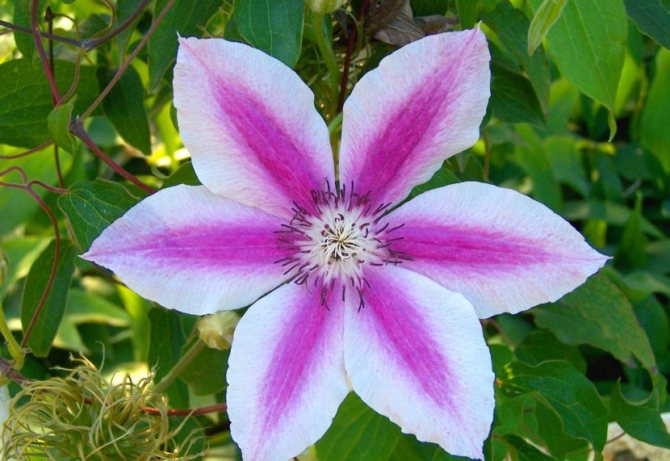
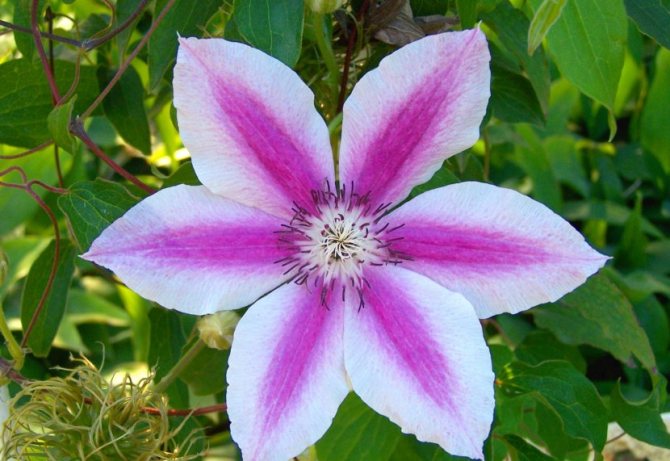
Recommendations for planting and caring for clematis in open ground

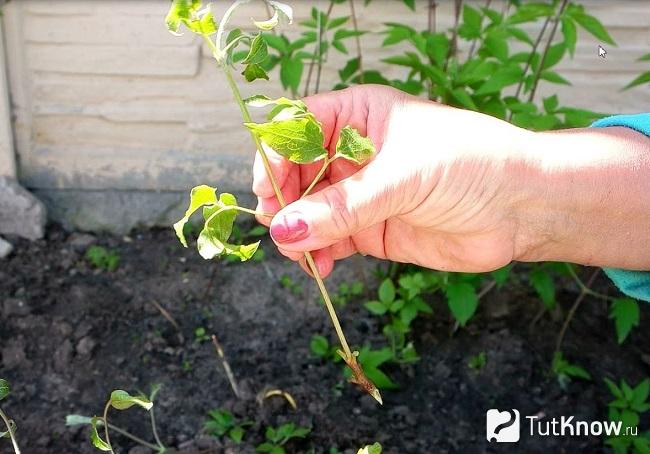
- Landing place.
It is important that the vine bushes in such a location are carefully protected from gusts of cold wind. It will take a lot of sun to bloom, but it is important that the planting site is in the shade at noon. They are planted away from the underlying groundwater, preferably on a hill. Do not plant next to buildings or fences, as flowing water will harm the liana. - Soil for clematis
should be slightly alkaline, rich in nutrients and organic matter. It is better that these are loams with good drainage. If the substrate is poor, then you will need to apply fertilizers – a bucket of peat and river sand, 2-3 buckets of vegetable humus with soil (compost), superphosphate and dolomite flour (150 and 400 g, respectively). Fertilizers must be mixed one year before planting. - Clematis planting
can be carried out in the spring or autumn. Between the seedlings they stand 15-30 cm. If the root system of the seedlings is closed, then planting can be done in summer. Before planting, all root processes are examined, if they dry out, the seedling is immersed in the roots for a couple of hours in a bucket of water. When planting in the spring (the last week of April or the first decade of May), it will be necessary to periodically pinch the tops of the shoots, which will stimulate their branching and the growth of root shoots. When the flowering ends and the foliage withers, it is recommended to wrap the clematis seedlings with spunbond or lutrasil. Transplanting in spring is carried out in trenches, the depth of which is 50–70 cm, the approximate distance between them should be at least 0,5 m. Drainage material is placed on the bottom with a layer of 10–15 cm. Expanded clay, pieces of brick or crushed stone can act as it. After planting, the shoots are cut so that only a few internodes remain on them. After 2-3 years, when clematis seedlings grow 3 or more elastic roots equal to 10-15 cm in length, transplant is performed to a permanent place of their future growth. Be sure to place supports with a diameter of 10–12 mm in the pit so that the branches can cling to them. In regions with a warm climate, you can plant clematis in the fall according to the same rules. - Watering
held once a week. If the weather is hot, then moisturize 2-3 times a week. For young specimens, 1-2 buckets of water are needed, adult bushes will require 2-4 buckets. After watering, the soil is loosened and mulched. - fertilizers
when growing clematis, nitrogen-containing ones are introduced for growth, during budding – potash, after flowering – phosphorus. After summer pruning, they are fed with a full complex fertilizer (for example, Kemiroi-Universal). Every year with the arrival of spring, milk of lime is used – an aqueous solution based on chalk or dolomite flour. - How to prepare clematis for winter.
As soon as the last month of autumn comes, all leaves are removed from the clematis bush and the root collar is treated with copper sulfate (2% solution). If the weather is dry, then a bucket of humus is poured out under the base of the bush. The height of the hilling of the bushes is 10-15 cm, a sand-ash mixture is used (250 g of wood ash are bred in a bucket of sand). If the species is not frost-resistant, then after laying the shoots in the root zone on the soil, they are covered with dried foliage, a wooden box is placed on top, which is wrapped in non-woven material. Then the entire structure is covered with a layer of soil reaching 20–25 cm. The shelter is removed when the threat of recurrent frosts has passed. Then the stems are lifted and placed on supports. - The use of clematis in landscape design.
If the variety of clematis is shrub with climbing shoots, then with the help of branches you can cover bare tree trunks, high walls. Vine branches can be used to wrap up pillars of gazebos and pergolas, and plant trellises. In the case of growing a species with creeping branches, such plants are planted in curbs so that the shoots serve as a screen for low walls, trellises. Well undersized clematis are suitable for landscaping balconies. If it is necessary to form group plantings, arrange rocky rockeries or rock gardens, as well as organize decorative single plantings, it is recommended to use types of clematis with upright shoots.
Pruning clematis is performed during the growing season and before winter. The operation is carried out depending on the group of plants:
- Plants of group A
in June and after flowering, weakened shoots are cut off. In November, the bushes are spud. - For clematis group B
the branches are shortened to 0,5–1 m, keeping only 4–10 buds. If the shoot is weak, it is cut to the root. By winter, the branches are removed from the supports, carefully twisted and placed in the root zone. - Passwords group C
require cutting several times from spring to November. With the arrival of October, all branches are cut to the level of the substrate or slightly higher.
Cut the vine
Clematis pruning is carried out both at the growth stage and for the winter period. In the first A-group of clematis, only weak shoots are cut off. This is best done at the end of flowering, around June.
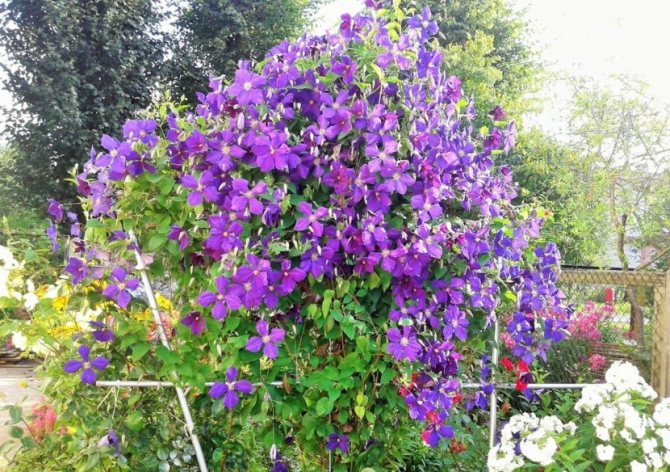

Pruning of the B-group is carried out at a distance of up to one meter, keeping from 2 to 5 pairs of young buds, removing weak shoots.
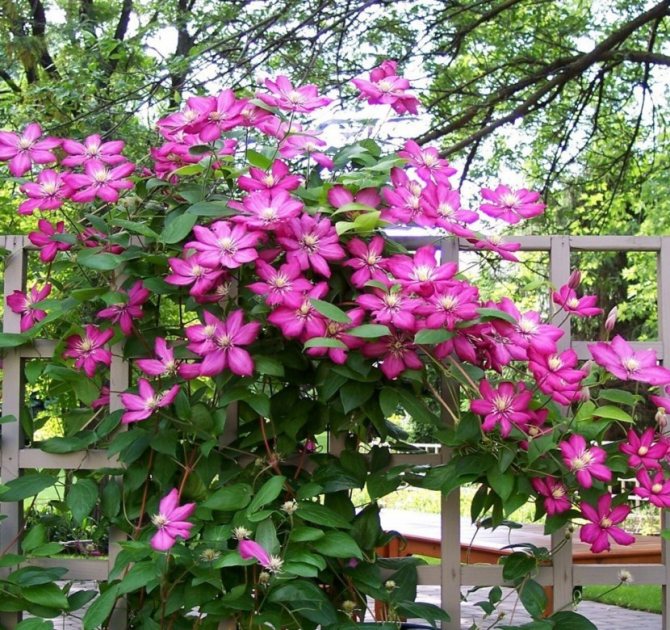
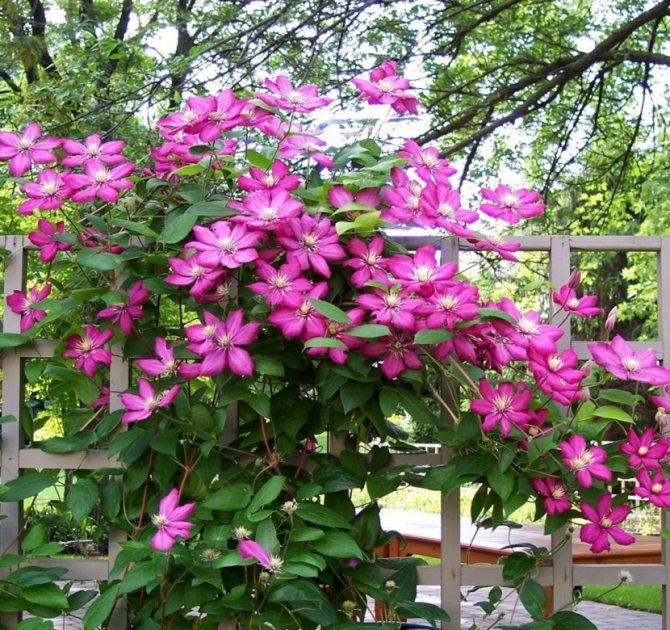
In the C-group, pruning is carried out in several stages during the growing season.
After flowering, clematis must be prepared for wintering. To do this, the neck should be covered with a solution of copper sulfate 2%, a bucket of humus is poured under the root and spud up to 15 cm high.

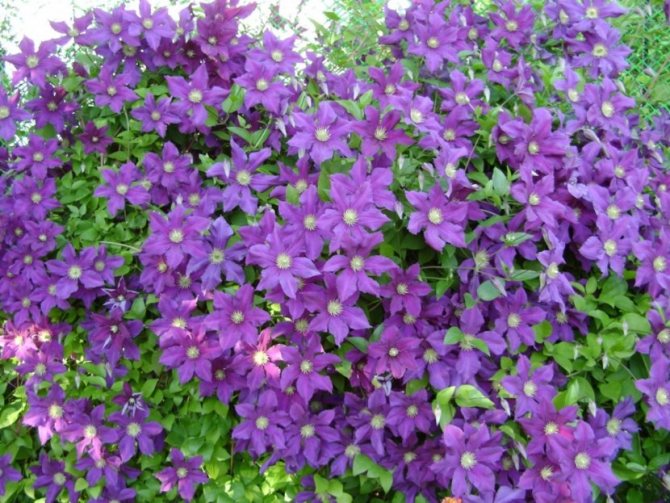
Dry leaves are poured onto the plant from above and covered with a box made of wood, covering it from above with a protective material in the form of roofing material, roofing felts or other. To prevent it from being blown away, a brick or a layer of earth is placed on top.
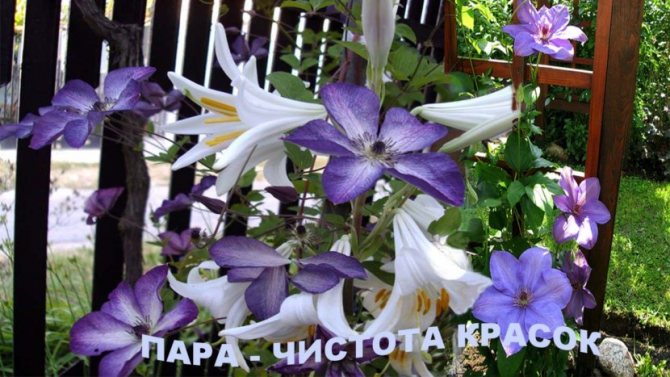

Photos of clematis flowers show that for proper growth and an attractive appearance, this plant needs to be supported. It can be designed in the form of arches, fans, pyramids.

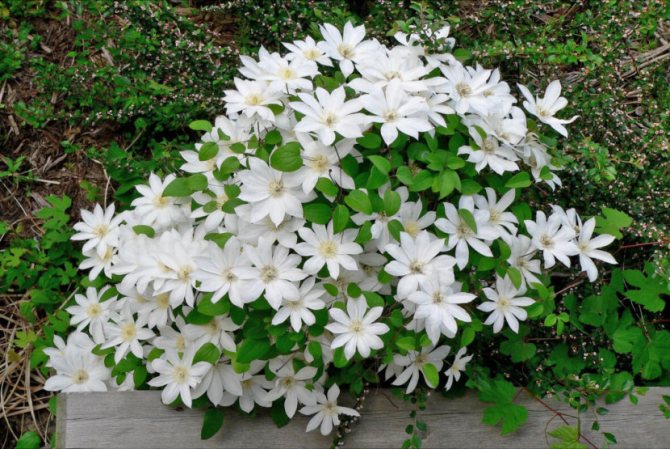
To do this, it is worth choosing durable materials, since an adult clematis plant has a large mass.
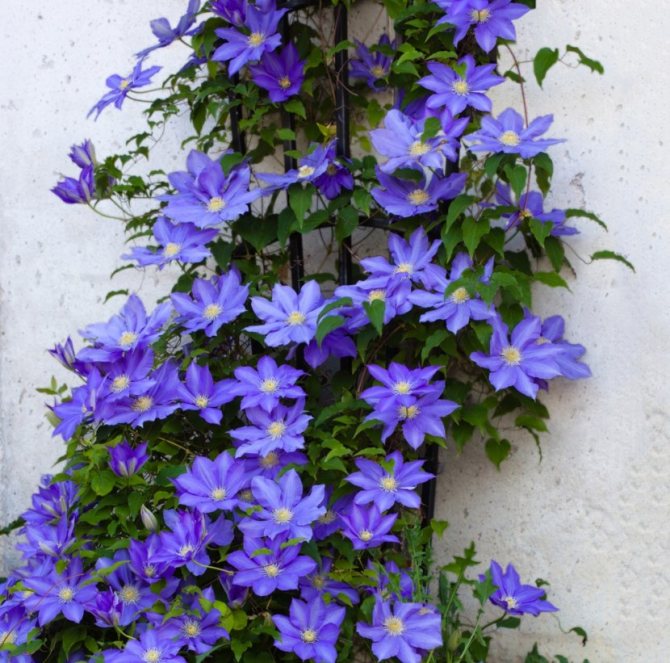
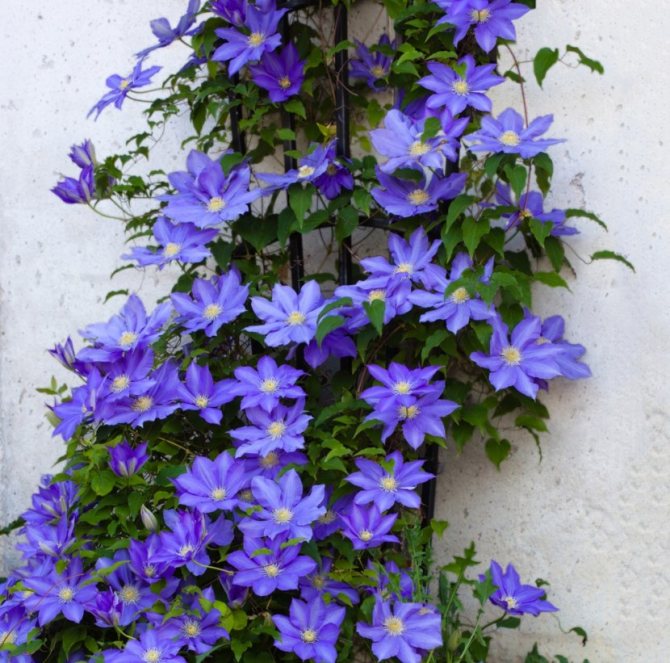
Breeding methods for clematis
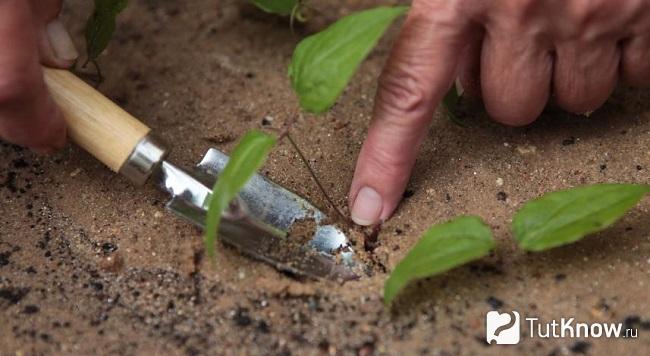
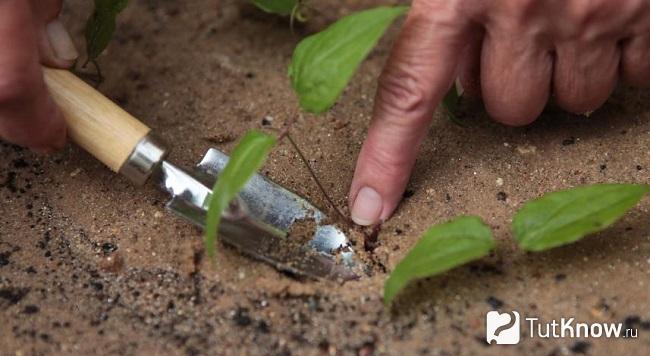
You can use both the seed and the vegetative method (dividing an overgrown bush, rooting cuttings or pinning branches).
Seed Reproduction
All varieties of clematis are usually divided into 3 groups:
- The size of the seeds is large, the sprouts appear unevenly over 1,5–8 months (varieties – purple, woolly, Zhakman, etc.).
- Seeds are medium – germinate for 1,5–6 months (species – whole-leaved, Chinese, six-petal, etc.).
- The seeds are small, which germinate very amicably in 14–112 days (vines – Tangut, grape-leaved, etc.).
The seeds are taken this season, but with proper storage, they can remain viable for up to 4 years. The seeds of the 1st group are sown after harvesting or in the first week of December, for the 2nd group the time is suitable in mid-January, the sowing of seeds of the 3rd group is carried out in March-April. Before sowing, it is necessary to prepare the material – for 10 days the seeds are soaked in warm water, which is changed 4–5 times a day. It is better to adapt a thermos for this. The soil is made up of equal parts of river sand, peat and soil. It is moistened and seeds are evenly distributed on the surface.
A layer of sand is laid on top of the seeds, the thickness of which should be no more than 2-3 diameters of the seed. The crops are slightly pressed from above, the container with them is wrapped in polyethylene or glass is placed on top. The germination temperature is 25-30 degrees. Crop maintenance consists of watering every other day through a sump, so as not to wash out the seeds and ventilate.
When the sprouts become species, it is recommended to transfer the container with seedlings to a well-lit place, without direct sunlight. When a pair of true leaves is formed in young clematis, a pick is carried out in separate pots with the same soil. When the spring warmth is established and there will be no frost, the seedlings are transplanted into open ground.
Reproduction by dividing the clematis bush
This operation is best done in the spring. For division, a specimen is selected that has reached 6 years of age, and has never been ill. You should not take an older bush, as it has a powerful root system, in which case more problems will arise during division. Clematis is dug around the perimeter and carefully removed from the soil with the help of garden forks, the soil will need to be removed from the roots. Using a pruner, divide the root system into parts. It is important that each of the divisions have buds of resumption of growth on the root collar. After that, you can plant them in a prepared place in the garden.
Reproduction by layers
Mid-autumn is suitable for this operation. All foliage is removed from the shoots, and the part that has faded is cut off to the first developed bud. A plait is woven from the shoots, it is then placed in a groove dug in the soil, previously covered with peat at the bottom. In this position, the branches are fixed and peat chips are poured on top. This layer is also covered with a substrate, which needs to be crushed a little. For wintering, it is recommended to cover the clematis with a layer of fallen dry leaves or put spruce branches on top. With the arrival of spring, the locations of the clematis branches are watered abundantly, preventing the topsoil from drying out.
When shoots can be seen from under the soil, the soil next to them is mulched using humus or peat chips. As soon as September arrives, most of the young clematis can be moved to a permanent place of growth. In order not to injure the root system of the plants, garden forks are used when extracting from the soil. If the shoots are laid on summer days, then there is a possibility that they may die with the arrival of cold weather.
Reproduction of clematis by pinning branches
This method is used in the spring. Shoots of last year are suitable for him. The pots are filled with a substrate of soil with peat and buried below ground level next to the vine bush. The branches are tilted to the buried pot and fixed there in knots. This is done so that the water after irrigation stays longer in the container next to the shoot. Until autumn, as the shoot grows, pouring soil into the pot is carried out, while trying to build a mound above the rooting site. When September comes, you can carry out the separation and transplantation of the vine seedling.
Where to Plant
Reproduction of Lomonos is a relatively simple matter. The planting technology of such plants depends primarily on their variety. Small-flowered Clematis usually propagate simply by seed. Large-flowered species are sold in specialized stores as seedlings. Also, such Clematis are often propagated by cuttings.

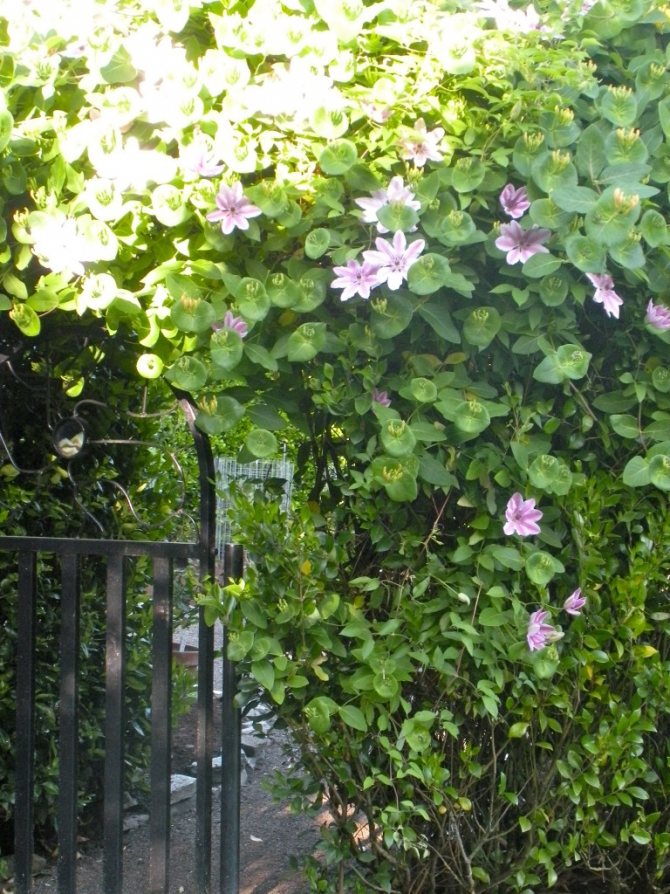
Like most other representatives of the flora, Lomonosas are light-loving plants. Therefore, it is advisable to plant such a decorative culture in a well-lit area. One of the features of Clematis is, among other things, the fact that they react very badly to overheating of the soil. Therefore, when choosing a place for such a plant, care must be taken to ensure that it is in partial shade in the afternoon.
Clematis also does not like wetland. Therefore, in areas with clay soil, it is supposed to equip drainage for it.
The place under Clematis, among other things, should also be well protected from the wind. Otherwise, the shoots of this plant in the future will be very confused, and the flowers will break and wither.
The soil of the plant Lomonosos love neutral or slightly alkaline. Sometimes the owners of such ornamental crops are interested, for example, in why Clematis does not bloom. Very often this happens precisely because the plant is planted in acidic soil. To remedy the situation, the plant must be transferred to a new place, or slaked lime must be added to the hole.
You should try to choose the right place for Lomonos right away. Species of this culture with fibrous roots are relatively easy to transplant. But Clematis with a tap root system react extremely painfully to this procedure.
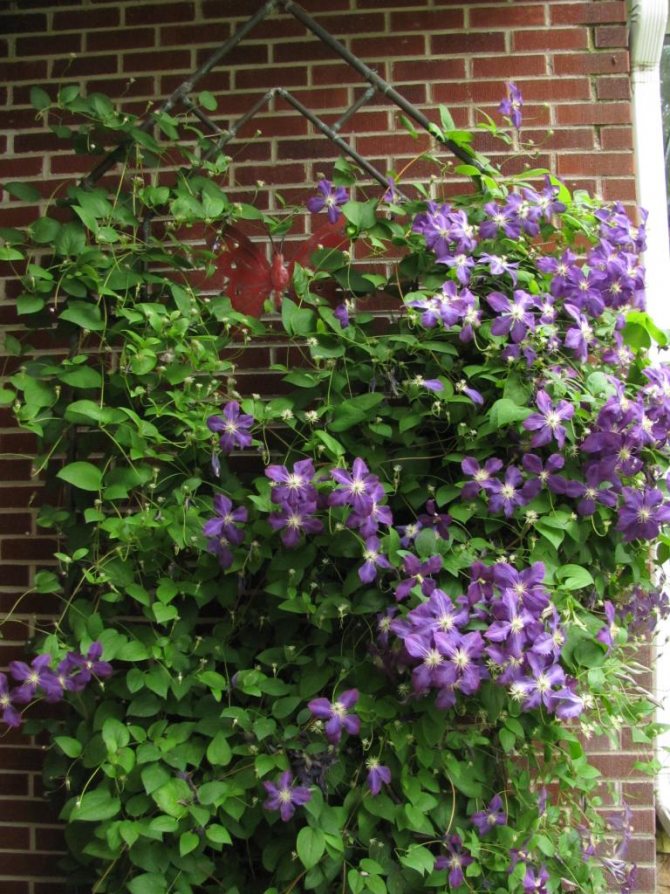

How to protect clematis from diseases and pests?
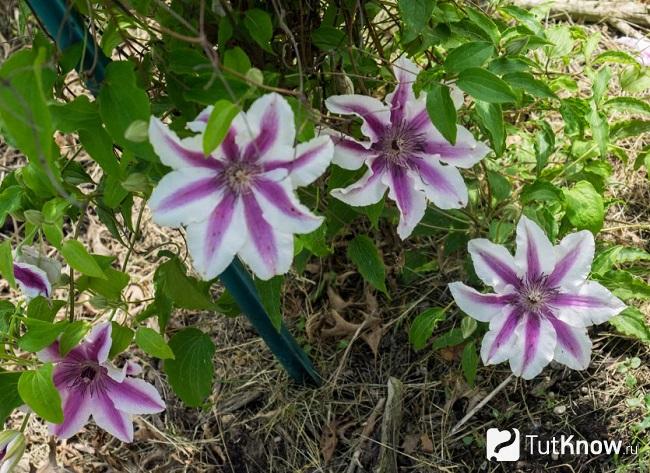
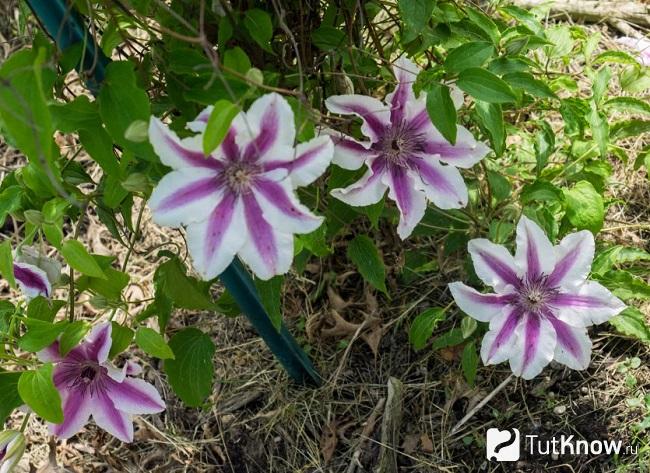
If the cultivation technique is violated, clematis can suffer from fungal diseases. The leaves lose their turgor and begin to wither. At the same time, the beginning of troubles can be noticed only with the arrival of spring. At the end of spring days, you need to remove the affected parts, and pour the liana under the root with a fungicidal agent (Fundazol or Azocene). At the same time, they adhere to a 2 percent concentration of the solution. In case of severe damage, the plant is dug up together with an earthen clod and burned, the place of its growth is subject to disinfection. Apply the same drugs or a strong solution of potassium permanganate.
If signs of gray rot or powdery mildew are noticed, then treatment with similar fungicides is performed. When red-brown spots appear on foliage and stems, these are signs of rust. Treatment with Oxychom or copper oxychloride is recommended, you can use a 1-2% solution of Bordeaux liquid. In the summer, clematis may suffer from achkozchitosis, in this case, 1% copper sulfate is needed.
Viral diseases (for example, yellow mosaic) can become a problem, but the plant cannot be cured, it must be destroyed. Such diseases are transferred from plantings of hosts, sweet peas and delphiniums, peonies and phloxes, or aquilegia.
The pest is a leaf or root nematode. In order to fight these small round worms, marigold bushes are planted next to the vine.
Facts to note about clematis
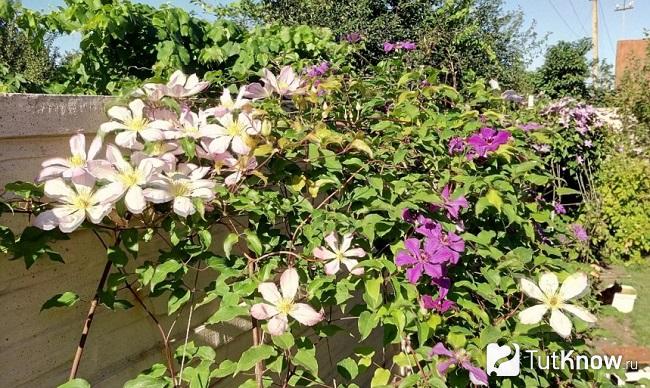
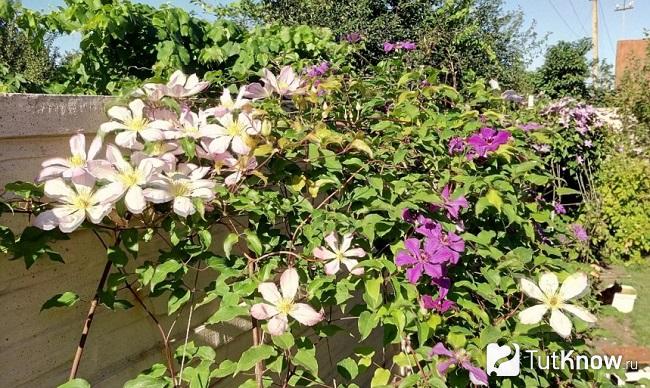
The purposeful cultivation of clematis in Western European countries began in the XNUMXth century, but Japanese flower growers have already appreciated clematis and decorated their gardens with an unpretentious liana with beautiful flowers. Russian flora lovers got acquainted with the plant at the beginning of the XNUMXth century, while vines were grown mainly as a greenhouse culture. Today, through the efforts of breeders, a large number of new species and varieties of clematis have been bred. But since the plants, in spite of this, do not differ in resistance to frost, they will need to organize a shelter for the winter period.
There are many synonymous names for clematis:
- On the Belarusian territory, it is called a warrior or zhgunets due to the fact that the juice of the Clematis vitalba variety, getting on the skin, can not only cause its redness, but also lead to a burn.
- In the Mogilev region, using the “bearded” infructescence of direct clematis (Clematis recta), local residents removed warts, and the plant was called a warthog.
- On the territory of Europe, clematis has more than 200 items, among which are maiden hair, an old man’s beard, the joy of a traveler, a flame and a damn bump, and many others.
Video about growing clematis:
Photos of clematis:
Landing
In one place, most varieties of Clematis can grow up to 20 years. Therefore, the planting places for such plants must be prepared as carefully as possible. Most often, holes of 60x60x60 cm are dug under such vines. Further, two buckets of rotted manure and 1 peat and sand are added to the excavated soil. Also mixed into the substrate:
- superphosphate and bone meal – 100 g each;
- mineral fertilizer, ash and lime – 200 g each
At the next stage, crushed stone is poured onto the bottom of the pit, drainage is made with a layer of prepared soil and it is carefully compacted. Further, in the middle of the pit, a rigid support is stuck. Then a pile of soil mixture is poured, a seedling is installed and its roots are spread over the pile. The plant is covered in such a way that its growing point, as well as the first pair of upper buds, are deepened.
When using this planting technology, Clematis will subsequently give a lot of shoots. If the growth point is flush with the ground, the plant will have no more than 1-2 branches in the future.
The distance between the pits in a row during planting is usually left at 90 cm.But in this case, it all depends on the specific type of clematis. Lush varieties are planted away from each other. Species with a less dense crown are located, respectively, in a row more often.

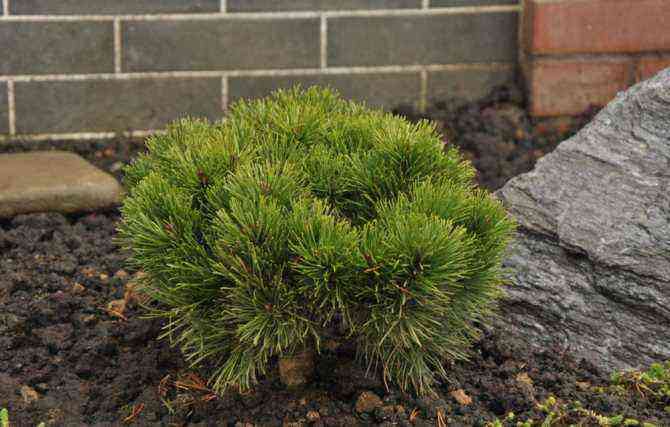
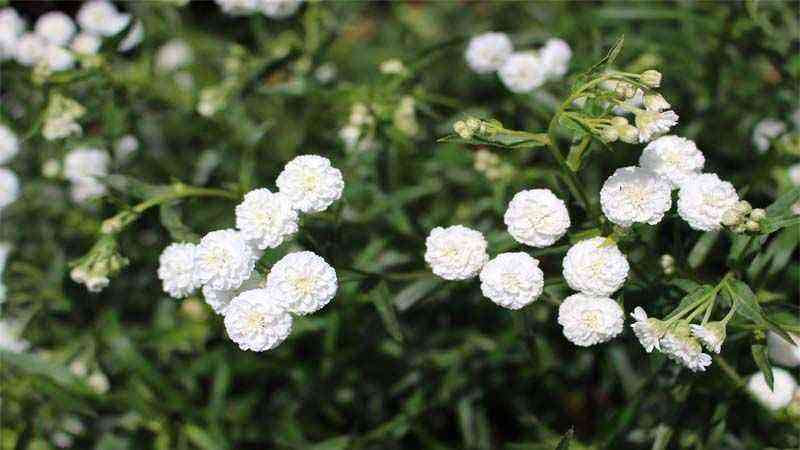
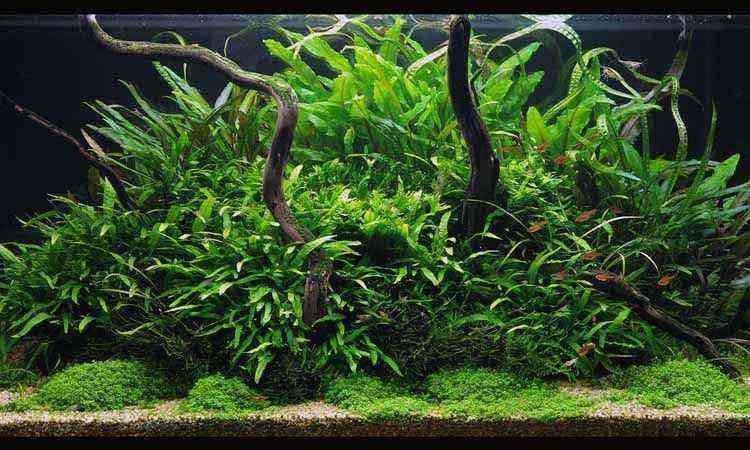
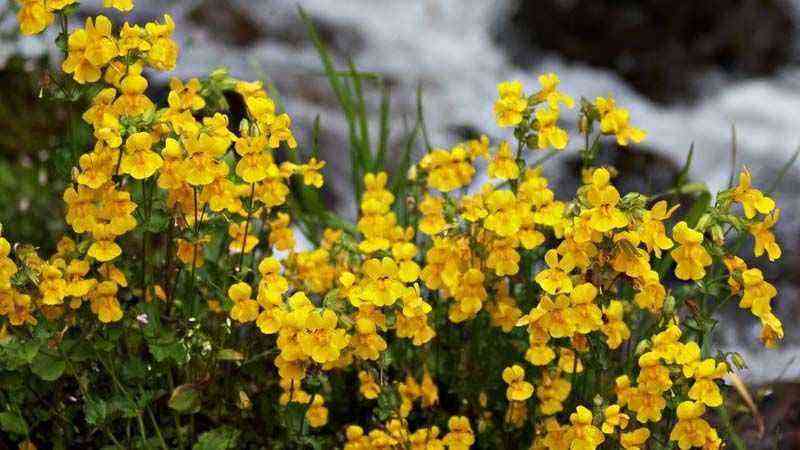

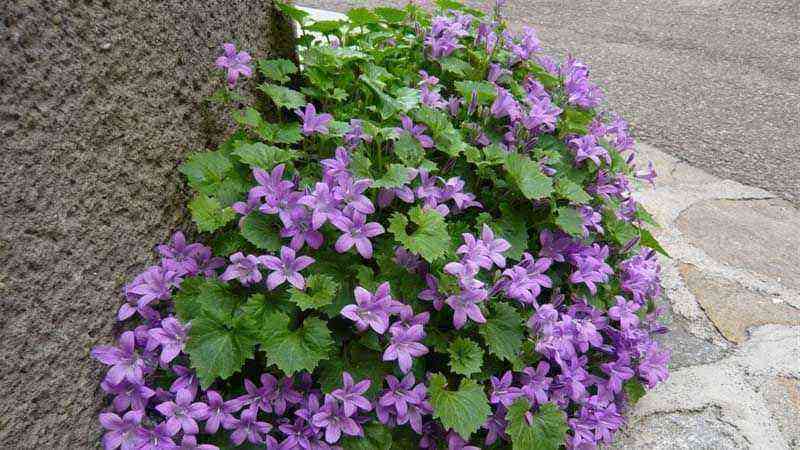
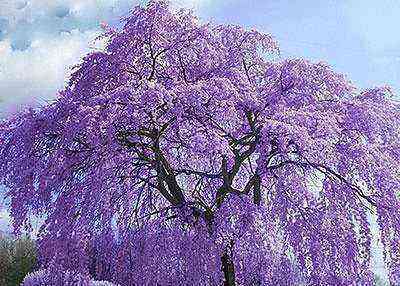
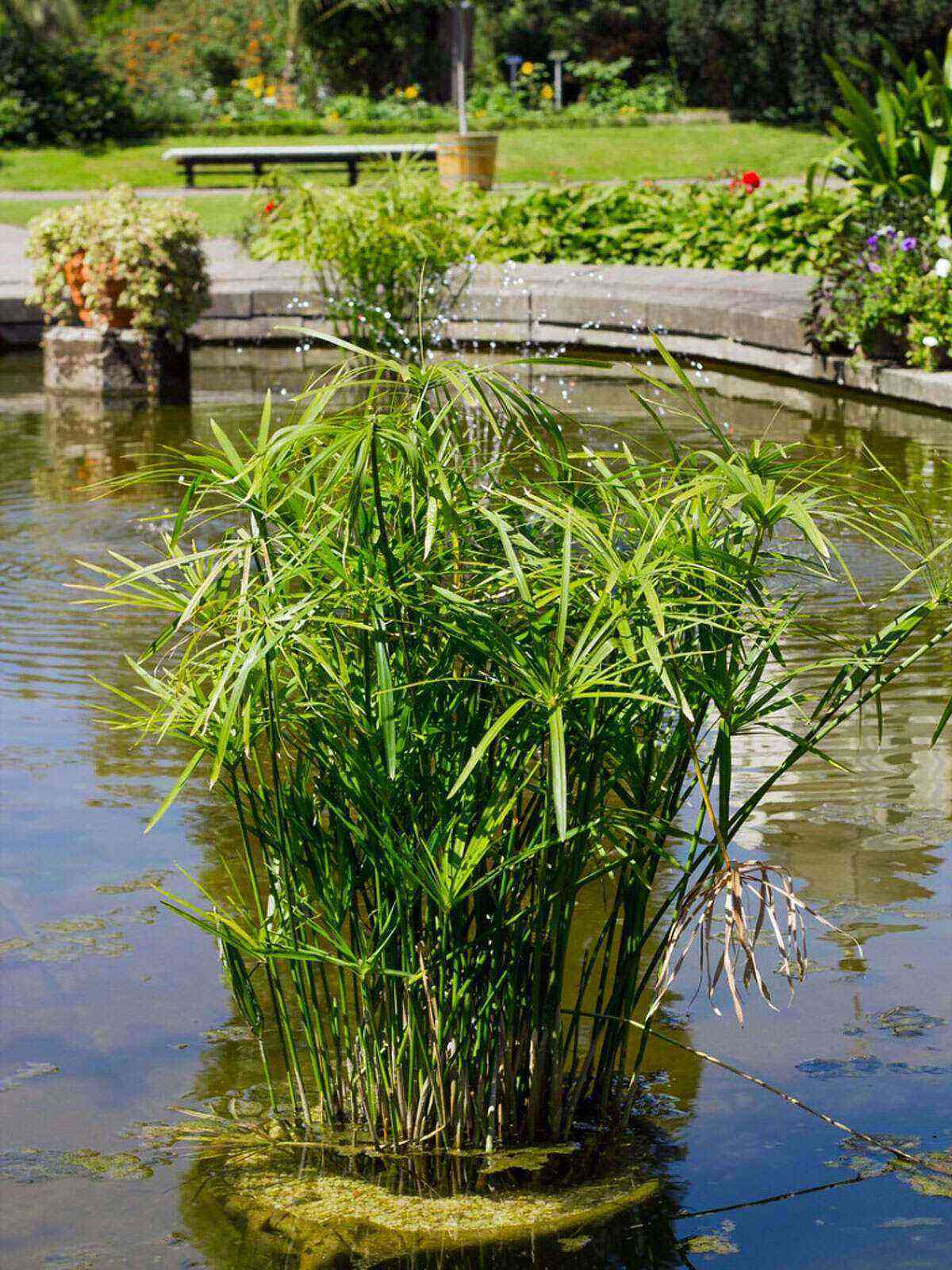
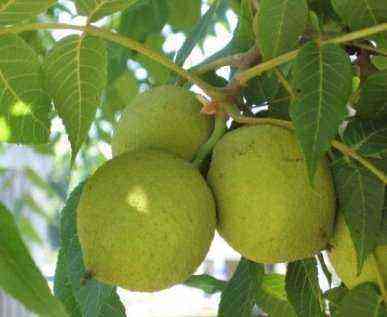

![Cultivo de Magnolia stellata [magnolia estrellada] Cultivo de Magnolia stellata [magnolia estrellada]](https://farmer-online.com/wp-content/uploads/2021/05/Cultivo-de-Magnolia-stellata-magnolia-estrellada.jpg)
